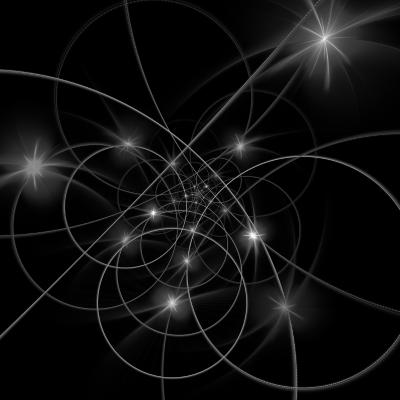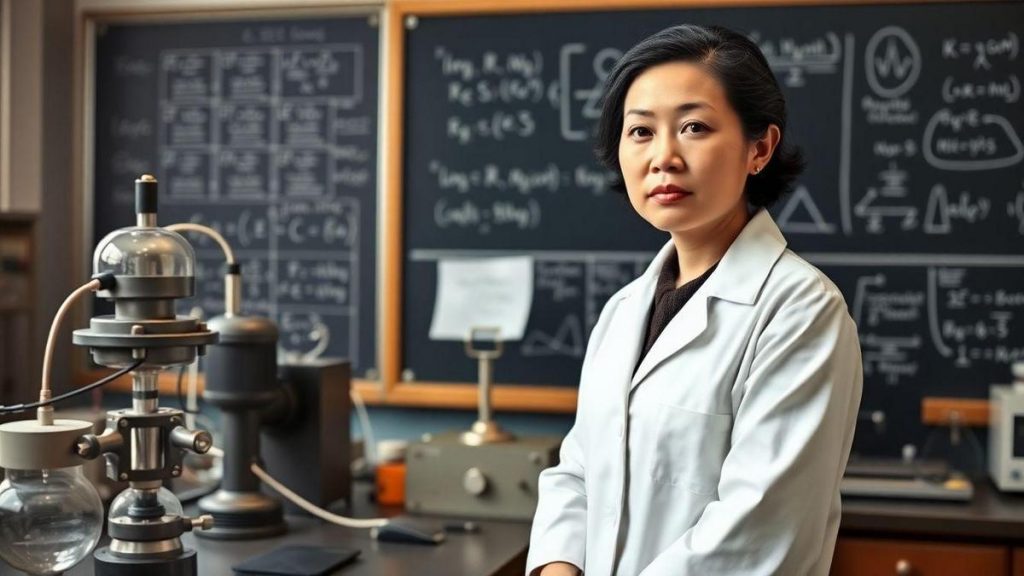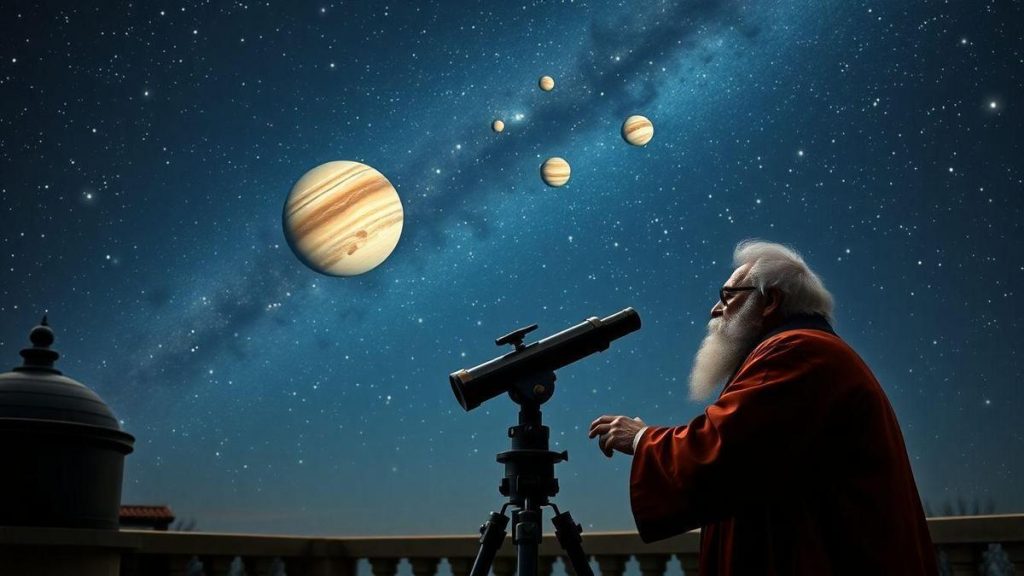The heliocentric theory marked a radical break with the prevailing worldview of Antiquity and the Middle Ages. Proposed by Nicolaus Copernicus, it placed the Sun at the center of the solar system, challenging the existing geocentric model. This change sparked intense debates, both scientific and theological.
The validation of the heliocentric theory gained strength with the observations of Galileo Galilei in the 17th century. Using a telescope, he obtained evidence that supported Copernican theory. His discoveries were crucial for consolidating a new understanding of the cosmos.

Galileo’s Telescopic Observations
Galileo Galilei was a pioneer in the scientific use of the telescope to observe the sky. Starting in 1609, he began a series of revolutionary astronomical observations. His work revealed phenomena that contradicted the traditional geocentric model.
Among his most important discoveries were the moons of Jupiter. He observed that these bodies orbited a planet and not the Earth. This proved that not everything revolved around our planet, as claimed by the Aristotelian view.
Galileo also identified the phases of Venus, a phenomenon incompatible with geocentrism. These phases could only occur if Venus orbited the Sun, as in the heliocentric model. This was decisive evidence in favor of Copernicus’ proposal.
Another significant finding was the sunspots. They showed that the Sun was an imperfect and mutable body. This contradicted the idea of perfect celestial spheres and reinforced the need for a new cosmological model.
Philosophical Importance of the Heliocentric Theory
The acceptance of heliocentrism profoundly changed how humans see themselves in the universe. By removing Earth from the center, this theory challenged the notion of humanity’s centrality. This had a direct impact on philosophy, religion, and culture.
The displacement of the Earth from the center of the universe was a blow to anthropocentrism. Man ceased to be the absolute focus of creation. This new vision required humility before a vast and impersonal cosmos.
Heliocentrism also influenced rational and scientific thought. It propelled the development of the experimental method. Observation and reason began to surpass tradition and authority.
This philosophical transformation paved the way for the Enlightenment. Science came to play a central role in the search for truth. Trust in reason and observation began to shape Western thought.
Reactions of the Church and Society
The reaction of the Catholic Church to Galileo’s ideas was intense and controversial. The heliocentric theory was seen as a threat to the literal interpretation of the Scriptures. Defending this model entailed social and political risks.
In 1616, heliocentrism was formally declared heretical. Galileo was warned not to defend it publicly. Even so, he published the “Dialogue Concerning the Two Chief World Systems” in 1632, maintaining his position.
As a consequence, Galileo was tried by the Inquisition. In 1633, he was condemned and forced to recant his ideas. He spent the rest of his life under house arrest, but his discoveries continued to circulate.
Despite the initial opposition, the heliocentric view gained supporters. Scientists and thinkers of the 17th and 18th centuries followed in Galileo’s footsteps. Over time, the Church also revised its position, recognizing the value of his work.
The heliocentric theory, initially proposed by Nicolaus Copernicus in the 16th century, revolutionized the way we understand the universe. Before Copernicus, Ptolemy’s geocentric model, which placed the Earth at the center of the universe, was widely accepted. However, the heliocentric theory suggested that the Sun, not the Earth, was the center of our solar system, with the planets, including Earth, orbiting around it. This idea challenged established beliefs and faced strong initial resistance from both the scientific community and religious institutions.
The validation of the heliocentric theory gained strength with Galileo Galilei’s astronomical observations in the early 17th century. Using a telescope, Galileo made discoveries that provided crucial empirical evidence for the heliocentric model. His observations of Jupiter’s satellites, the phases of Venus, and sunspots were fundamental in challenging the geocentric paradigm and promoting a new understanding of the cosmos. In this article, we will explore how Galileo’s observations worked, the advantages of validating the heliocentric theory, and the methods used by Galileo to validate this revolutionary theory.
How Galileo’s Observations Work

Galileo Galilei’s observations were a milestone in astronomy and science as a whole. Using a telescope he himself improved, Galileo was one of the first to point this instrument to the sky, revealing a previously unknown universe. His observations began in 1609, and he quickly discovered celestial features that contradicted the established geocentric model.
One of Galileo’s first and most significant discoveries was the moons of Jupiter. In January 1610, he observed four bright points around the planet, which he later identified as moons: Io, Europa, Ganymede, and Callisto. This discovery was crucial, as it demonstrated that not everything revolved around the Earth, as stated by the geocentric model. The existence of celestial bodies orbiting another planet provided strong evidence for the heliocentric model.
Galileo also observed the phases of Venus, which, like the Moon, showed a full cycle of phases. In the geocentric model, it was impossible to explain these phases, but in the heliocentric model, they made perfect sense, since Venus orbited the Sun, creating different angles of illumination as seen from Earth. This observation was further compelling proof supporting Copernicus’ theory.
In addition, Galileo observed sunspots, which were temporary dark areas on the surface of the Sun. The observation of these spots challenged the Aristotelian view that celestial bodies were perfect and immutable. Sunspots showed that the Sun had activity and changes—something the geocentric model could not satisfactorily explain. Galileo’s discoveries, therefore, not only provided evidence for the heliocentric theory but also paved the way for a new era of astronomical observations.
Advantages of Validating the Heliocentric Theory
The validation of the heliocentric theory brought numerous advantages to science and humanity as a whole. Firstly, it allowed for a more accurate and coherent understanding of the movement of celestial bodies. The heliocentric model simplified astronomical calculations, eliminating the need for complex epicycles used in the geocentric model to explain the retrograde motion of planets.
Moreover, the acceptance of the heliocentric model encouraged the development of new technologies and observation methods. With the new perspective of the solar system, astronomers and scientists were motivated to develop more precise instruments, such as more powerful telescopes and astronomical clocks. This technological evolution enabled more detailed and accurate observations, driving the advancement of astronomy and science in general.
The heliocentric theory also had a significant impact on philosophy and how humanity sees itself in the universe. By displacing Earth from the center of the universe, the theory challenged the prevailing anthropocentric view and promoted a more humble and realistic understanding of humanity’s place in the cosmos. This change in perspective opened doors to new ways of thinking and questioning, stimulating the development of the scientific method.
Finally, the validation of the heliocentric theory had profound implications for education and the dissemination of knowledge. With the acceptance of the heliocentric model, educational curricula were reformed to include this new understanding of the universe. This not only democratized scientific knowledge but also inspired generations of scientists, astronomers, and thinkers to explore and better understand the universe around us.
How Galileo’s Validation of the Heliocentric Theory Works

Galileo’s validation of the heliocentric theory was a meticulous process that involved careful observation, rigorous documentation, and strategic dissemination. To understand how Galileo validated the heliocentric theory, it is important to consider the methods and approaches he used.
Telescopic Observations: Galileo used a telescope, an innovative tool at the time, to observe the sky in detail. His observations of Jupiter’s satellites, the phases of Venus, and sunspots provided visual evidence supporting the heliocentric model.
Careful Documentation: Galileo meticulously documented his observations and discoveries in scientific publications, such as the “Sidereus Nuncius” (Starry Messenger) of 1610. This documentation allowed other scientists to verify his findings and replicate his observations.
Challenging the Establishment: Galileo did not hesitate to challenge the established geocentric model and the authorities that supported it. He promoted debates and discussions about his discoveries, defending the heliocentric model based on his evidence.
Strategic Dissemination: Galileo used his position and connections to disseminate his discoveries and ideas. He corresponded with other scientists and intellectuals of the time, promoting his observations and arguing in favor of the heliocentric model.
Resistance and Controversy: Galileo’s validation of the heliocentric theory faced significant resistance, especially from the Catholic Church, which saw the heliocentric model as a threat to religious doctrine. Galileo was tried and condemned by the Inquisition, but his discoveries continued to influence science.
Lasting Impact: Despite the controversy, Galileo’s observations had a lasting impact on science. They paved the way for future discoveries and established a new standard for scientific observation and validation.
Galileo’s validation of the heliocentric theory was a milestone in the history of science. His methods and discoveries not only challenged the status quo but also established a new paradigm for scientific investigation. Galileo’s courage and persistence in defending his observations and ideas continue to inspire scientists and thinkers to this day.
Frequently Asked Questions
What is the heliocentric theory?
The heliocentric theory says that the Sun is at the center of our solar system, not the Earth.
How did Galileo validate the heliocentric theory?
Galileo used his telescope to observe that Venus has
phases, like the Moon. This could only happen if Venus orbited the Sun.
What were Galileo’s observations?
Galileo saw moons orbiting Jupiter and the phases of Venus. This challenged the idea that everything revolved around the Earth.
Did the Church accept Galileo’s discoveries immediately?
No, the Catholic Church resisted the idea. Galileo was even condemned by the Inquisition.
Why was Galileo’s validation of the heliocentric theory important?
Because it changed the way we understand the universe. We don’t revolve around the Earth. The Sun is the center of our solar system.




